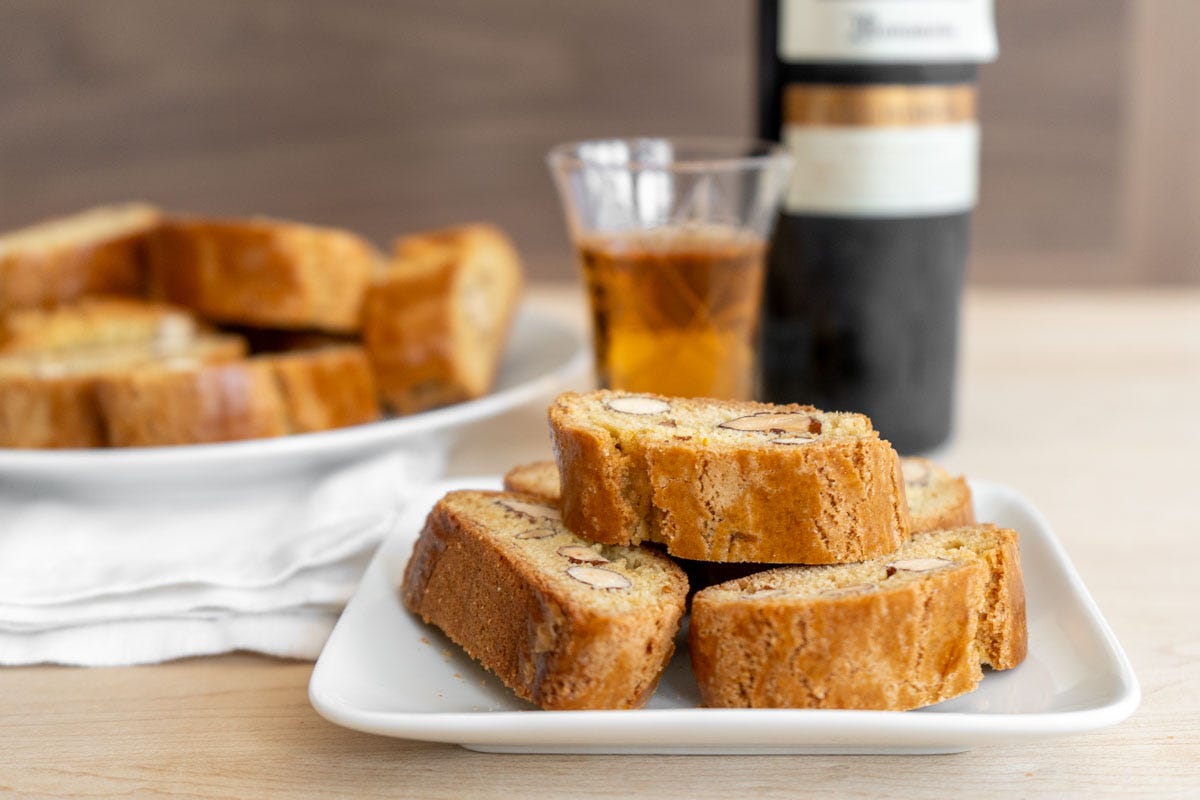Since we bought the Montalcino house and are spending more time in Tuscany, we have a renewed appreciation for Tuscan regional cuisine, including cantucci, Tuscany’s traditional almond biscotti.
Cantucci are delicious at breakfast with coffee or tea or as an afternoon snack, but they are best enjoyed after a meal, dipped in Vin Santo, Tuscany’s sweet dessert wine. It’s not uncommon for the waiter to bring complimentary cantucci and Vin Santo to the table after you’ve paid the bill as a gesture of appreciation. Light and just sweet enough, they’re the perfect end to a delicious meal.
Biscotto, the singular form of biscotti, means twice-cooked (bis-cotto). Cantucci are twice-based cookies, one of many regional variations of Italian biscotti. Originally from the town of Prato, cantucci are now found everywhere in Tuscany.
Closer to Rome, we make tozzetti instead of cantucci. Made with hazelnuts instead of almonds, they are otherwise nearly identical. Over the years, we’ve made tozzetti and cantucci at home, especially around the Christmas holiday, but they never come out quite right. Authentic cantucci are light, dry, and friabile, an Italian word that means crumbly, in a good way. Ours were always too dense and cake-like.
After our most recent trip to Tuscany, we decided we needed to stop making subpar cantucci and figure out how to do it right.
We perused a couple of decades-old Tuscan cookbooks, Marcella Hazan’s classic, Essentials of Italian Cooking, Giorgio Locatelli’s Made in Italy, Rizzoli’s La Cucina, and The Silver Spoon, the English version of Cucchiao d’Argento, the ultimate authority on Italian cuisine, first published in the 1950s.
We also looked for recipes online. La Cucina Italiana’s English website has a recipe, but it was really unconvincing, or at least the photo accompanying the recipe was. We liked the version on La Cucina Italiana’s Italian site, though.
With a handful of recipes in hand, we did a side-by-side comparison. The results were surprising. Some recipes called for butter, while others did not. Some used Marsala, while others opted for honey. The proportions of flour to sugar varied significantly, and so did the oven temperature and the cooking time.
We were puzzled. Every Tuscan cantuccio we’d eaten, whether bakery-prepared or store-bought, was remarkably consistent. Why did recipes vary so much? The only option was to start baking!
The first recipe we tried was too cake-like and not sweet enough. The second recipe was better, but the texture was still not right. A breakthrough happened when we tried the recipe on La Cucina Italiana’s Italian site. The cantucci were much improved and really close to authentic. They just needed more almonds, a bit more sweetness, and a lighter egg wash. We tried increasing the proportions of almonds and sugar, but the dough flattened out while baking. We tried again, making just the slightest tweaks, and voilà (oh wait, that’s French), they came out perfect.
Here’s our recipe, if you want to try them at home.


Cantucci Toscani
Makes approx. 28 cantucci
Ingredients
100 g raw almonds
2 eggs
180 sugar
290 g 00 flour
½ tsp baking soda
50 g salted butter, refrigerator temperature
1 Tbsp honey
Zest of 1 orange
1 egg yolk
1 Tbsp water
Tools & Equipment
Kitchen scale
Stand mixer
Baking sheet
Parchment paper
Cutting board
Sharp knife
Zester
Wooden spoon
Pastry brush
Directions
Preheat the oven to 175°C / 350° F.
Place the almonds on a baking sheet lined with parchment paper and toast them in the oven for 10 minutes. Remove them from the hot baking tray and allow them to cool.
Increase the oven temperature to 190° C / 375° F.
Use a stand mixer to briefly mix the sugar and two eggs. Do not overmix.
Add the flour and baking soda. Mix on medium speed until the dry ingredients are incorporated into the dough.
Add the butter, orange zest, and honey and mix until incorporated.
Remove the mixing bowl and stir the almonds in by hand, using a wooden spoon or your hands.
Sprinkle a little flour onto a cutting board. Transfer the dough from the mixing bowl to the cutting board and divide it into two pieces.
Use your hands to roll each piece of dough into a log.
Prepare an egg wash by mixing the egg yolk with 1 tablespoon of water.
Use a pastry brush to brush each roll with the egg wash.
Transfer each roll onto a baking sheet lined with parchment paper.
Bake at 190° C / 375° F for 25 minutes.
Transfer the logs to a cooling rack and allow them to cool for 10 minutes.
Replace the parchment paper on the baking tray.
Using a large, sharp knife, slice the logs into cantucci about 2-3 cm wide.
Lay the cantucci on their sides on the parchment paper-lined baking sheet and return them to the oven for 5 minutes. Turn them over and let them bake 2 more minutes.
Let the cantucci cool completely before serving.
Notes
We prefer Italian 00 flour, such as Antimo Caputo, but all-purpose flour will also work.
Pairing
Cantucci are traditionally enjoyed with Vin Santo. This Tuscan dessert wine, which translates to Holy Wine, reportedly acquired its name during the 14th century in the Tuscan countryside near the city of Siena when wine left over from mass was used to cure illness and disease. One of our favorites is Vin Santo La Chimera by Castello Monsanto.
What’s on your Easter Table?
Stay tuned for next week’s newsletter, where we write about the traditional Easter meal and share our recipe and the story behind the traditional Easter dessert, pastiera napolitana.







